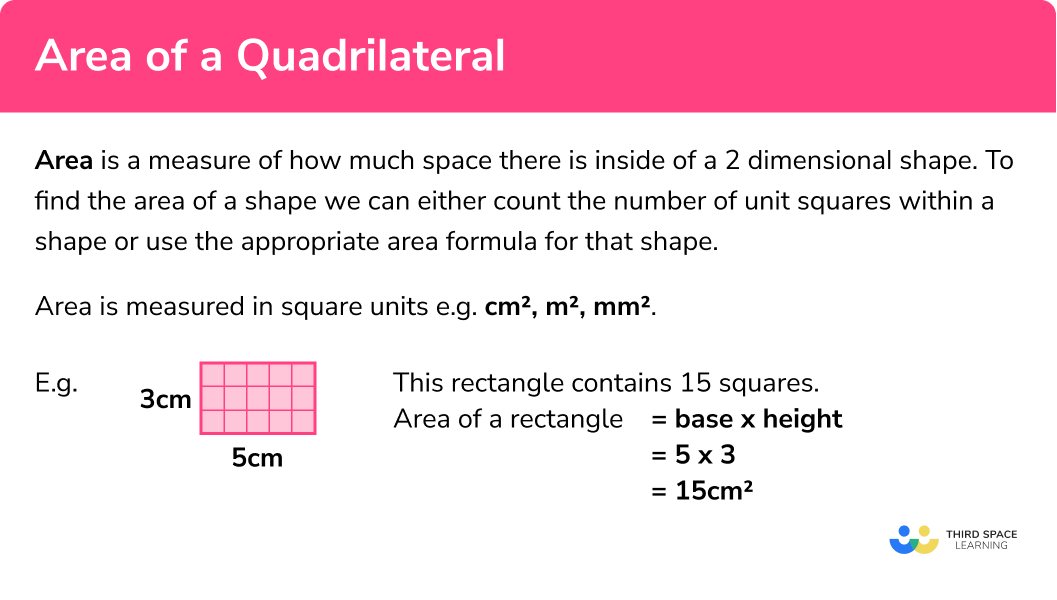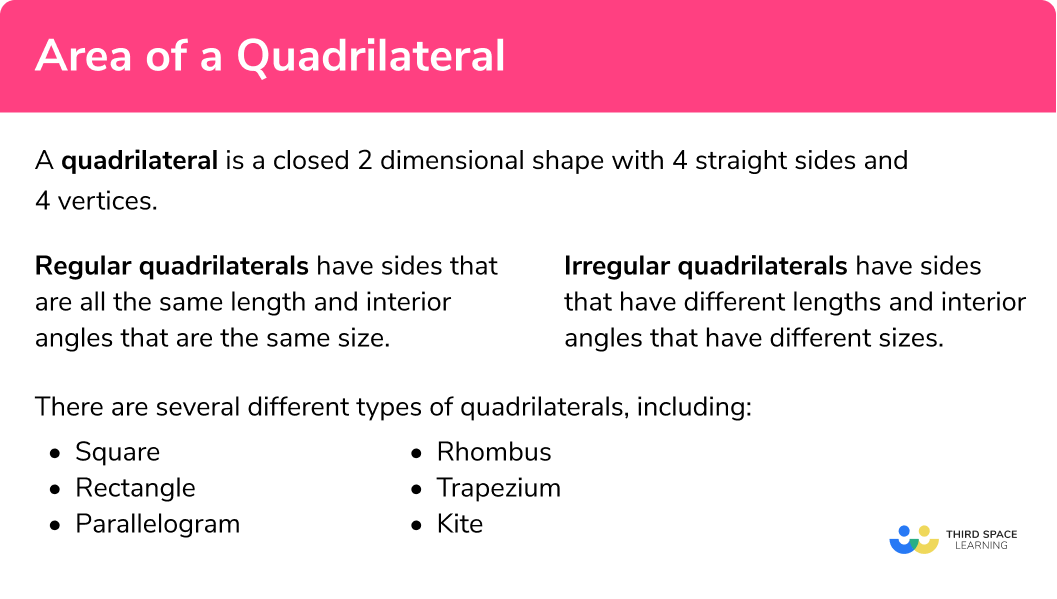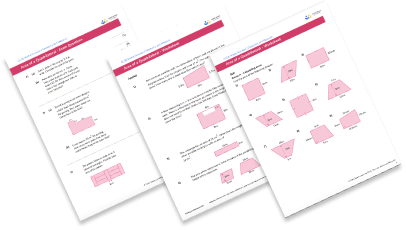One to one maths interventions built for KS4 success
Weekly online one to one GCSE maths revision lessons now available
In order to access this I need to be confident with:
Types of quadrilaterals Arithmetic Converting metric units BIDMAS Faces, edges and verticesThis topic is relevant for:

Area Of A Quadrilateral
Here we will learn about about the area of a quadrilateral including how to find the area of a rectangle, square, parallelogram and trapezium. You will also learn how to find the area of compound shapes made from more than one quadrilateral and find missing lengths given an area.
There are also area of a quadrilateral worksheets based on Edexcel, AQA and OCR exam questions, along with further guidance on where to go next if you’re still stuck.
What is area of a quadrilateral?
Area of a quadrilateral is a measure of how much space there is inside of a 2 dimensional shape four sided shape.
To find the area of a shape we can either count the number of unit squares within a shape or use the appropriate area formula for that shape.
Area is measured in square units e.g.
E.g.
This rectangle contains 15 squares.
What is area?

What are quadrilaterals?
A quadrilateral is a closed 2 dimensional shape with 4 straight sides and 4 vertices.
Regular quadrilaterals have sides that are all the same length and interior angles that are the same size.
Irregular quadrilaterals have sides that have different lengths and interior angles that have different sizes.
There are several different types of quadrilaterals:
Square:
A square is a closed 2 dimensional shape with four straight sides of equal length and four right angles (90°).
Rectangle:
A rectangle is a closed 2 dimensional shape with four straight sides and four right angles (90°). It has two pairs of parallel sides that are equal.
Parallelogram:
A parallelogram is a closed 2 dimensional shape with four straight sides. The opposite sides of a parallelogram have the same lengths and are parallel.
Rhombus:
A rhombus is a closed 2 dimensional shape with four equal straight sides.
Trapezium:
A trapezium is a closed 2 dimensional shape with four straight sides and only one pair of parallel sides.
Kite:
A Kite is a closed 2 dimensional shape with four straight sides. It has two pairs of adjacent sides (sides that are next to each other )that are equal to each other.
What are quadrilaterals?

How to name quadrilaterals
We usually refer to quadrilaterals by using assigning letters to each of their vertices.
E.g.
This is quadrilateral
How to calculate the area of a rectangle, square, parallelogram and trapezium
We can use formulae to calculate the area of the following shapes:
Area of a rectangle/square:
Area of a parallelogram:
In order to calculate the area of a rectangle, square or parallelogram:
- Substitute the values into the formula. (Make sure the units are the same for all measurements e.g. all
cm ). - Work out the calculation.
- Add the correct units.
Area of a trapezium:
A Trapezium is a trapezoid shape, meaning that it only has one pair of parallel sides. In order to calculate the area of a trapezium we need to use the following formula.
In order to calculate the area of a trapezium:
- Substitute the values into the formula.
- Do the calculation.
- Add the correct units.
We can use the following formula to work out the area of a rhombus and the area of a kite:
Where

Area of quadrilateral worksheet

Get your free area of a quadrilateral worksheet of 20+ questions and answers. Includes reasoning and applied questions.
DOWNLOAD FREE
Area of quadrilateral worksheet

Get your free area of a quadrilateral worksheet of 20+ questions and answers. Includes reasoning and applied questions.
DOWNLOAD FREERelated lessons on area
Area of a quadrilateral is part of our series of lessons to support revision on area. You may find it helpful to start with the main area lesson for a summary of what to expect, or use the step by step guides below for further detail on individual topics. Other lessons in this series include:
- Area
- Area of a circle
- Area of a triangle
- Area of a trapezium
- Area of a parallelogram
- Area of compound shapes
- Pi r squared
- Area of a rhombus
- Area of an isosceles triangle
- Area of an equilateral triangle
- Area of a right angled triangle
- How to work out area
- Area of a rectangle
- Area of a hexagon
- Area of a pentagon
Area of quadrilateral examples
Example 1: area of a square
Find the area of the quadrilateral:
- Here the height is 8. Since it is a square, the base is also 8.
2 Work out the calculation.
3 Add the correct units.
The measurements on this square are in cm so the area will be measured in
Example 2: area of a rectangle, different units
Find the area of the rectangle:
Substitute the values into the formula.
Here the base is 11m and the height is 400cm.
Notice that the base measurement is in m whereas the height measurement is in cm.
The easiest thing to do here is to change 400cm to 4m so that both measurements are in m. (You could also change 11m to 1100cm.
Do the calculation.
Add the correct units.
The measurements on this rectangle are in m so the area will be in m2:
Example 3: area of a parallelogram
Calculate the area of the parallelogram:
Substitute the values into the formula.
Do the calculation.
Add the correct units.
The measurements on this parallelogram are in mm so the area will be in mm2.
Example 4: area of a trapezium
Find the area of the following trapezium:
Substitute the values into the formula.
Here
Do the calculation.
Remember to apply BIDMAS when working this out.
Add the correct units.
The measurements on this trapezium are in cm so the area will be in cm2 .
Example 5: area of a trapezium
Find the area of the following trapezium:
Substitute the values into the formula.
Here
Do the calculation.
Add the correct units.
The measurements on this trapezium are in km so the area will be in km2.
How to calculate the area of compound shapes with quadrilaterals
Sometimes a shape is made from two or more quadrilaterals put together. We can calculate the area of these shapes by breaking them down into individual quadrilaterals.
- Draw lines to split the shape into quadrilaterals (this step is not always necessary). Label the quadrilaterals A, B, C,…
- Consider each quadrilateral individually
a) work out any measurements that you need.
b) calculate the area using the methods above. - Add or subtract the relevant areas to find the total area.
- Add the correct units.
Example 6: compound shape made from 2 quadrilaterals
Find the total area of the shape shown below:
Draw lines to split the shape into quadrilaterals if necessary. Label the quadrilaterals A, B, C,…
This shape is already split into two quadrilaterals. Label them
Consider each quadrilateral individually and:
a) work out any measurements that you need.
b) calculate the area using the methods above.
Quadrilateral A:
a) For the rectangle we need to know the base and the height, which are shown.
b)
Quadrilateral B:
a) For the trapezium, we need to know
We can see
To get
b)
Add or subtract the areas.
Add the areas together:
Add the units.
Total area
Example 7: compound shape made from three quadrilaterals
Find the total area of the shape shown below:
Draw lines to split the shape into quadrilaterals if necessary. Label the quadrilaterals A, B, C,…
Split the shape into quadrilaterals and label them A, B and C. This can be done in two different ways – whichever way you choose will work.
Consider each quadrilateral individually and:
a) work out any measurements that you need.
b) calculate the area using the methods above.
Using the first way of splitting:
Quadrilateral A:
a) The base of quadrilateral
b)
Quadrilateral B:
a) The base is 10m. The height is 20 – 11 = 9m.
b)
Quadrilateral C:
a) The base is
b)
Add or subtract the areas.
Add the areas together:
Add the units.
Total area
Example 8: subtracting areas
Find the shaded area:
Draw lines to split the shape into quadrilaterals if necessary. Label the quadrilaterals A, B, C,…
The shape is already split into two quadrilaterals. Label them
Consider each quadrilateral individually and:
a) work out any measurements that you need.
b) calculate the area using the methods above.
Quadrilateral A:
a) Here
b)
Quadrilateral B:
a)
b)
Add or subtract the areas.
This time we need to subtract the areas as the non-shaded area is being removed from the shaded area.
Add the units.
Shaded area
How to find a missing length
We will sometimes be given the area of a quadrilateral and then need to calculate an unknown length.
- Put the values you know into the formula.
- Solve the equation.
Example 9: missing length in a rectangle
Work out the height of the rectangle:
Put the values you know into the formula.
Here the area is 40 and the base is 10.
Solve the equation.
To solve this equation we need to divide by 10:
The height of the rectangle is
Example 10: missing length in a trapezium
Find the height of the following trapezium given that it has an area of 56cm2:
Put the values you know into the formula.
Here
Solve the equation.
The height of the trapezium is 7cm.
Common misconceptions
- Calculating perimeter instead of area
- Height of parallelogram
Using the wrong measurement for the height of a parallelogram.
- Wrong formula for area of a trapezium
A common error is to use the wrong formula for area of a trapezium, for example using the formula for area of a triangle instead
- Units
Using measurements with different units. Remember to make sure the units are the same for each length (e.g. all cm).
Practice area of quadrilateral questions
1. Find the area of the following square:




2. Find the area of the following parallelogram. Give your answer in
cm^2.




First we need to make the units the same. Here 70mm=7cm.
\begin{aligned} \text{Area }&=\text{ base }\times \text{ height}\\\\ &= 7 \times 6\\\\ &=42 \mathrm{~cm}^{2} \end{aligned}
3. Find the area of the following trapezium:




4. Find the area of the following shape:




Quadrilateral A:
\begin{aligned} \text{Area }&=3 \times 4\\\\ &=12\mathrm{~cm}^{2} \end{aligned}
Quadrilateral B:
\begin{aligned} \text{Area }&=12 \times 7\\\\ &=84\mathrm{~cm}^{2} \end{aligned}
\text{Total area: }12+84=96\mathrm{~cm}^{2}
5. Find the shaded area:




Quadrilateral A:
\begin{aligned} \text{Area }&=30\times20\\\\ &=600\mathrm~{~m}^{2} \end{aligned}
Quadrilateral B:
\begin{aligned} \text{Area }&=\frac{1}{2}(6+14)\times12\\\\ &=\frac{1}{2}\times 20 \times 12\\\\ &=120 \mathrm{~m}^{2} \end{aligned}
\text{Shaded area: }600-120=480\mathrm{~mm}^{2}
6. Find the height of the following parallelogram:




Area of quadrilateral GCSE questions
1. A plan of Rosie’s garden is shown below.
Rosie wants to buy grass seed to grow a lawn in the spaces not covered by the patio and the vegetable patch.
Each box of grass seed covers 20m^2 and costs £5.50 .
How much will Rosie need to spend on grass seed?
(5 marks)
Total area: \frac{1}{2} \times (8+12) \times 18
= 180 \mathrm{~m}^{2}
(1)
Area of patio: 5 \times 8 = 40 \mathrm{~m}^{2}
Area of vegetable patch: 3 \times 9 = 27 \mathrm{~m}^{2}
(1)
Area to be seeded: 180-40-27=113\mathrm{~m}^{2}
(1)
Boxes of seed: 113 \div 20 = 5.65
(1)
Need 6 boxes, so 6 \times \pounds 5.50 = \pounds 33 she will have to spend
(1)
2. Rita wants to tile a section of her kitchen wall, as shown below:
(a) Calculate the area of the wall that Rita wants to tile. Give your answer in cm^2.
(b) The tiles that Rita has chosen are square, with side length 20cm. How many tiles will Rita need?
(5 marks)
(a)
1.2m=120cm, 1.6m=160cm, 1m=100cm
(1)
\begin{array}{l} 120 \times 160 = 19200 \mathrm{~cm}^{2}\\\\ 320 \times 40 = 12800 \mathrm{~cm}^{2} \end{array}
(1)
Total area: 19200 + 12800 = 32000 \mathrm{~cm}^{2}
(1)
(b)
20 \times 20 = 400
(1)
3200 \div 400 = 80
(1)
3. The shape below is made from two identical rectangles. The area of the shape is 120cm^2
Calculate the height of the shape.
(3 marks)
Area of one rectangle: 60 \mathrm{~cm}^{2}
(1)
\begin{aligned} \text { Area }&=\text { base } \times \text { height } \\\\ 60&=5 \times h \end{aligned}
(1)
h = 12cm
(1)
Learning checklist
You have now learned how to:
- Calculate the area of a square, rectangle, parallelogram and trapezium
- Calculate the area of a compound shape
- Calculate missing lengths given an area
The next lessons are
Still stuck?
Prepare your KS4 students for maths GCSEs success with Third Space Learning. Weekly online one to one GCSE maths revision lessons delivered by expert maths tutors.

Find out more about our GCSE maths tuition programme.